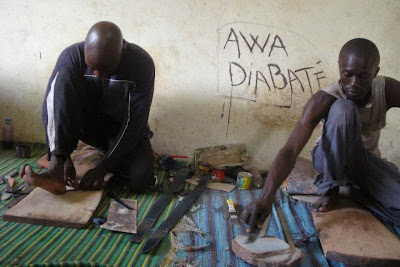It's very easy to get to; in Brighton we live around an hour from London, and it's less than a 5 minute walk from Camden Town tube station. Head towards Camden Lock, and it's just there on the left.
From the outside, it looks like it's going to be a very cool, but tiny restaurant, but appearances can be deceiving! You immediately head underground to the club/bar area, which is absolutely gigantic. I think the restaurant can serve around 600 people, plus a large bar area, and lots of very cool decorations! You get the African vibe instantly, with carvings on the walls, statues dotted around, and live African music (think lots of drums and dancing).
It's advisable to book in advance, especially for large parties. There were 5 of us, and we'd booked well in advance. The restaurant is an entire floor (down another level), and was pretty much full. They'd called to confirm with me the night before, and informed me that we'd have our table for 2 hours, which I was a bit worried about (I didn't want to be rushed), but in the end it was absolutely fine as we finished dot on 9pm. I don't know what they'd have done if we'd run over, but we didn't have to worry about that, and weren't rushed at all.
We'd been really excited about the food for weeks, and there's so much to choose from! We had water and bread to share while we decided, and even that was amazing. The bread was warm, and we had different types of butter (that admittedly my friend Holly mistook for cheese and ate on its own!)
The big draw of the menu is the large amount of game and exotic meat available. The food is pricey, but massively worth it, as they have a selection of meats including zebra, ostrich, buffalo, crocodile, springbok and others. Surprisingly, they also have a varied vegetarian selection; I used to be veggie (purely for taste rather than ethical reasons), and although I've now started eating meat again, I always prefer the veggie options.
We shared some crocodile cigars to start (crocodile spring rolls, with spices and vegetables), which were surprisingly nice. Crocodile appears to be a mixture between chicken and fish, but it's pretty tasty!
The best part of the whole evening (in our opinion) was the AMAZING cocktail we all shared. It was called a Cape Town Share, and had rum, watermelon and all sorts of amazing things in. It was served in a giant elephant which held our straws (too cute) with flaming alcohol served in a passion fruit! It lasted us all through our meal, and cost us £11 each, which isn't bad for a cocktail in a fancy London restaurant! I could have drank 10 of them, they were so yummy!
Three of the girls then had ostrich (they had sold out of buffalo, which Danielle was a bit disappointed about, but the ostrich was still good!), whilst Holly and I had sea bass (which was incredible). We had vouchers for 2-for-1 main meals, so we also got a springbok to share.
Both the ostrich and the springbok were red meat (which surprised me particularly for the ostrich), and were cooked medium-rare. The piece of springbok I had was particularly pink (I prefer my meat well done), but it was still very tasty! The quality of the food was phenomenal, and although the meats are around £30 per head, it's definitely worth it as a treat.
The good thing about nice food, is that it doesn't fill you up until you're stuffed, and we still had room for dessert! I wouldn't say dessert was its strongest point, but they were still very nice. I had a dark chocolate torte with Amarula cream, honeycomb and pretty sugar-work, and the others had Vanilla Crème Brulee (which looked amazing), and a Strawberry Trifle, which they also enjoyed.
It was then time for one more cocktail (I had a Madiba - passionfruit and melon!), before we headed upstairs to soak up some more of the atmosphere.
For everything that we had (bread, water, starter, main meal, dessert and two cocktails), we only spent around £65 each including service charge! Admittedly we had 2-for-1 vouchers (check out National Rail Days Out - always worth a look, and GroupOn have deals too), but I was still expecting it to be a lot more. The food was amazing quality, the restaurant itself was amazing, and we had quite a lot to eat and drink, and I was perfectly willing (and expecting) to pay a little more as a treat.
If you're just going for a drink, I think there is a charge to get in after a certain time (may be just on the weekends), but I don't think it was particularly extortionate for the area, and definitely worth it. They had several live acts while we were there, and there was plenty of space to sit and stand in the bar area. I didn't really realise how busy it was until we went to the toilets, as when you're sat at your table, you have plenty of room around you, and it's quite dark.
It's definitely somewhere to go for a treat, rather than every weekend, but I will definitely be going again! Whether you love Africa, or just want a different experience, it's something I'd highly recommend! http://www.shaka-zulu.com/












.jpg)


.jpg)


.jpg)
.jpg)
